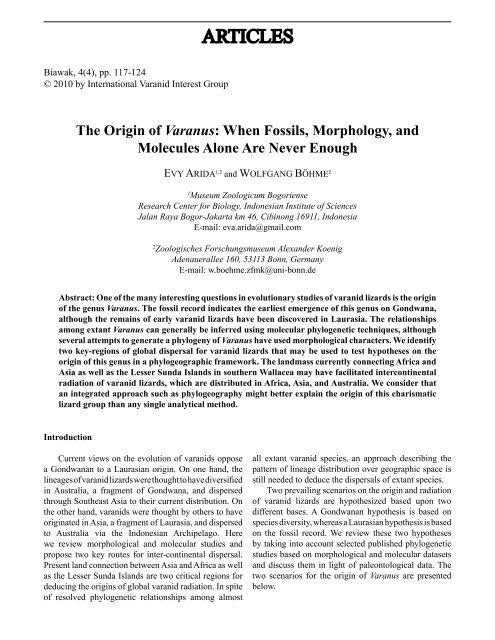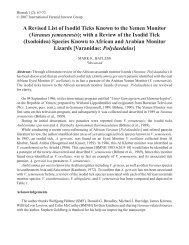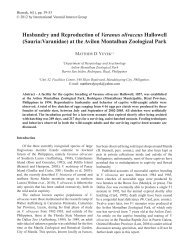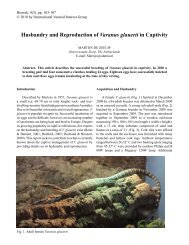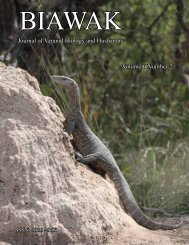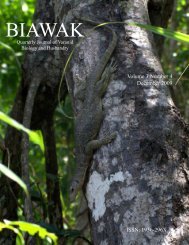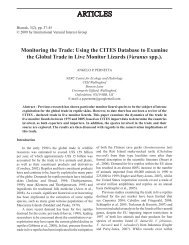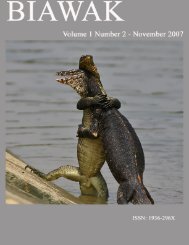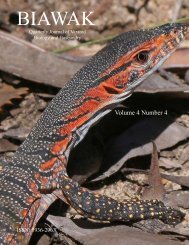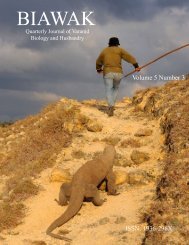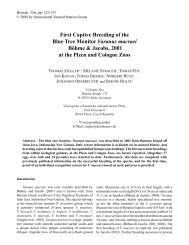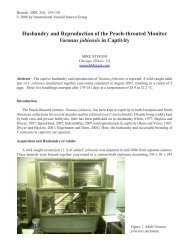BIAWAK - International Varanid Interest Group
BIAWAK - International Varanid Interest Group
BIAWAK - International Varanid Interest Group
- No tags were found...
You also want an ePaper? Increase the reach of your titles
YUMPU automatically turns print PDFs into web optimized ePapers that Google loves.
ARTICLES<br />
Biawak, 4(4), pp. 117-124<br />
© 2010 by <strong>International</strong> <strong>Varanid</strong> <strong>Interest</strong> <strong>Group</strong><br />
The Origin of Varanus: When Fossils, Morphology, and<br />
Molecules Alone Are Never Enough<br />
EVY ARIDA 1,2 and WOLFGANG BÖHME 2<br />
1<br />
Museum Zoologicum Bogoriense<br />
Research Center for Biology, Indonesian Institute of Sciences<br />
Jalan Raya Bogor-Jakarta km 46, Cibinong 16911, Indonesia<br />
E-mail: eva.arida@gmail.com<br />
2<br />
Zoologisches Forschungsmuseum Alexander Koenig<br />
Adenauerallee 160, 53113 Bonn, Germany<br />
E-mail: w.boehme.zfmk@uni-bonn.de<br />
Abstract: One of the many interesting questions in evolutionary studies of varanid lizards is the origin<br />
of the genus Varanus. The fossil record indicates the earliest emergence of this genus on Gondwana,<br />
although the remains of early varanid lizards have been discovered in Laurasia. The relationships<br />
among extant Varanus can generally be inferred using molecular phylogenetic techniques, although<br />
several attempts to generate a phylogeny of Varanus have used morphological characters. We identify<br />
two key-regions of global dispersal for varanid lizards that may be used to test hypotheses on the<br />
origin of this genus in a phylogeographic framework. The landmass currently connecting Africa and<br />
Asia as well as the Lesser Sunda Islands in southern Wallacea may have facilitated intercontinental<br />
radiation of varanid lizards, which are distributed in Africa, Asia, and Australia. We consider that<br />
an integrated approach such as phylogeography might better explain the origin of this charismatic<br />
lizard group than any single analytical method.<br />
Introduction<br />
Current views on the evolution of varanids oppose<br />
a Gondwanan to a Laurasian origin. On one hand, the<br />
lineages of varanid lizards were thought to have diversified<br />
in Australia, a fragment of Gondwana, and dispersed<br />
through Southeast Asia to their current distribution. On<br />
the other hand, varanids were thought by others to have<br />
originated in Asia, a fragment of Laurasia, and dispersed<br />
to Australia via the Indonesian Archipelago. Here<br />
we review morphological and molecular studies and<br />
propose two key routes for inter-continental dispersal.<br />
Present land connection between Asia and Africa as well<br />
as the Lesser Sunda Islands are two critical regions for<br />
deducing the origins of global varanid radiation. In spite<br />
of resolved phylogenetic relationships among almost<br />
all extant varanid species, an approach describing the<br />
pattern of lineage distribution over geographic space is<br />
still needed to deduce the dispersals of extant species.<br />
Two prevailing scenarios on the origin and radiation<br />
of varanid lizards are hypothesized based upon two<br />
different bases. A Gondwanan hypothesis is based on<br />
species diversity, whereas a Laurasian hypothesis is based<br />
on the fossil record. We review these two hypotheses<br />
by taking into account selected published phylogenetic<br />
studies based on morphological and molecular datasets<br />
and discuss them in light of paleontological data. The<br />
two scenarios for the origin of Varanus are presented<br />
below.


